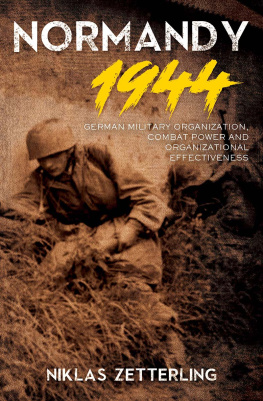Niklas Zetterling - Blitzkrieg: From the Ground Up
Here you can read online Niklas Zetterling - Blitzkrieg: From the Ground Up full text of the book (entire story) in english for free. Download pdf and epub, get meaning, cover and reviews about this ebook. year: 2017, publisher: Casemate, genre: History. Description of the work, (preface) as well as reviews are available. Best literature library LitArk.com created for fans of good reading and offers a wide selection of genres:
Romance novel
Science fiction
Adventure
Detective
Science
History
Home and family
Prose
Art
Politics
Computer
Non-fiction
Religion
Business
Children
Humor
Choose a favorite category and find really read worthwhile books. Enjoy immersion in the world of imagination, feel the emotions of the characters or learn something new for yourself, make an fascinating discovery.

- Book:Blitzkrieg: From the Ground Up
- Author:
- Publisher:Casemate
- Genre:
- Year:2017
- Rating:5 / 5
- Favourites:Add to favourites
- Your mark:
- 100
- 1
- 2
- 3
- 4
- 5
Blitzkrieg: From the Ground Up: summary, description and annotation
We offer to read an annotation, description, summary or preface (depends on what the author of the book "Blitzkrieg: From the Ground Up" wrote himself). If you haven't found the necessary information about the book — write in the comments, we will try to find it.
Blitzkrieg: From the Ground Up — read online for free the complete book (whole text) full work
Below is the text of the book, divided by pages. System saving the place of the last page read, allows you to conveniently read the book "Blitzkrieg: From the Ground Up" online for free, without having to search again every time where you left off. Put a bookmark, and you can go to the page where you finished reading at any time.
Font size:
Interval:
Bookmark:


Published in the United States of America and Great Britain in 2017 by
CASEMATE PUBLISHERS
1950 Lawrence Road, Havertown, PA 19083, USA
and
The Old Music Hall, 106108 Cowley Road, Oxford OX4 1JE, UK
Copyright 2017 Niklas Zetterling
Hardcover Edition: ISBN 978-1-61200-460-0
Digital Edition: ISBN 978-1-61200-461-7
A CIP record for this book is available from the British Library
All rights reserved. No part of this book may be reproduced or transmitted in any form or by any means, electronic or mechanical including photocopying, recording or by any information storage and retrieval system, without permission from the publisher in writing.
Printed and bound in the United States of America
Typeset in India by Lapiz Digital Services, Chennai
First published in Swedish as Blixtkrig: 193941 (Mnpocket, 2009)
For a complete list of Casemate titles, please contact:
CASEMATE PUBLISHERS (US)
Telephone (610) 853-9131
Fax (610) 853-9146
Email:
www.casematepublishers.com
CASEMATE PUBLISHERS (UK)
Telephone (01865) 241249
Fax (01865) 794449
Email:
www.casematepublishers.co.uk
The German Blitzkrieg has been the subject of many books, but a clear definition of the term has not yet emerged. Some authors have regarded it as tanks and aircraft conducting mobile operations in close cooperation. The image of tanks storming across open fields, supported by Stuka aircraft with howling sirens diving towards their targets, has often epitomized the Blitzkrieg campaigns of 193941. However, that image is at odds with the German operations conducted during the initial years of World War II. Admittedly, there are examples of successful cooperation between tanks and air power, but this was far from the norm. Most importantly of all, operations rarely hinged upon successful airground cooperation. Still, there is no lack of books emphasizing tanks and air power as the key to the German victories of 193941. However, this book approaches the Blitzkrieg from a different point of view; it presumes that the word Blitzkrieg simply denotes German warfare as it was conducted on the battlefields in 193941 and attempts to find out how it appeared from the eyes of the junior commanders and enlisted men.
Any historical work depends on the sources used. For various reasons, sources from the opposing side in a military conflict are often used and books on the Blitzkrieg are not different. Estimates, judgments and assumptions made by those who confronted the Blitzkrieg have been used in many books. Another widely used source are memoirs of the German generals who participated in the Blitzkrieg campaigns. These sources are certainly not without problems. In war, the understanding of the enemy is hazy. Even when the intelligence may present accurate data, an accurate understanding of the enemy does not follow automatically. Memoirs are widely known for often being self-serving, and the books written by the German generals are no exception. In addition to the less-than-perfect accuracy provided by such sources, they also tend to view the events from a certain perspective. This is of course evident in memoirs, as generals and other high-ranking officers are much more likely to write books or be interviewed after the war than ordinary soldiers. As they are no more than humans, they tend to explain success or failure predominantly from their point of view, which may or may not be the most important perspective.
The German victories were as surprising as they were swift. Allied decision-makers wanted to uncover the Germans secrets quicklythey had to do something very soon or risk larger defeat. Consequently, the Allies had to rely on the incomplete information available to find answers. In such circumstances, false conclusions often follow, which may turn into myths lingering for decades.
Previous authors such as Robert A. Doughty, James Corum, and Karl-Heinz Frieser have argued that the German victories in the early part of the war rested less upon tanks and aircraft and more on German military traditions predating the invention of the tank and the aircraft. Rather than creating a new way of war based on recent technological developments that differed radically from previous concepts, the Germans fitted the new weapons into their existing strategies. They focused on independent action, initiative, flexibility, decentralized decision-making and mobility. At the core of the concept was how men acted on the battlefield; this emphasis was particularly pronounced in the lower levels of the military structure. The German victories rested upon the quality of the small units.
Given the scope of the operations conducted in 193941, it is impossible to cover them all in detail. I have chosen to focus on how the Blitzkrieg operations were experienced by the enlisted men, the junior officers commanding platoons, companies and battalions, and other men who worked together with them, such as surgeons and field chaplains. Such descriptions are less common in the literature than the generals perspective.
In the last decade, I have been fortunate to spend much time at the German military archive in Freiburg. Gradually, I have found documents of a kind that is difficult to findwar diaries, debriefing reports and other papers from the battalion and company level. Most of these papers were destroyed in 1945, but some did survive. Unfortunately, they cannot be located by the standard search aids, but with time, I have found several documents of the kind needed to write a book like this. The reports and war diaries written soon after the events are the main source used, but private diaries have also been important, as well as printed sources. A significant part of the sources on which this book is based have never been used before. They have allowed me to describe how a company commander led his tanks, how a crew worked inside a tank and the role of the repair services, to name a few examples. The experiences of the individuals are highlighted, but when taken together they also form part of the greater perspective.
The book is divided into seven chapters. The first provides a brief outline of the development of the German warfare concept up to 1939. is devoted to Operation Barbarossa, the huge German assault on the Soviet Union. The seventh and final chapter is a reflection on the German Blitzkrieg campaigns. Those parts devoted to the campaigns are longer, allowing for the reader to follow individual soldiers and small combat units. However, I have endeavored to fit such narratives into a broader perspective to convey an understanding of the factors that shaped the Blitzkrieg. Thus, I hope the reader will better understand why the Germans reaped their succession of victories 193941.
The cold and the snow gave the landscape outside Moscow a character befitting the time of year, with the dark night sky contrasting against the white ground. The silence was almost palpable to the sentries of the German 21st Panzer Regiment, who kept a vigilant eye on the surroundings while their comrades tried to snatch some sleep. However, it was difficult to sleep in the bitter cold unless one could find shelter in a building.
The next day was Christmas Eve, signalling the beginning of a festival the soldiers would normally enjoy, but this time the situation was very different. The attack on the Soviet Union had been launched in beautiful summer weather and tremendous success had been achieved; innumerable prisoners and huge quantities of booty had been captured. The Germans constantly appeared to be on the verge of victory, but somehow it eluded them. When the fall was imminent, the Germans at last launched the great offensive towards Moscow. It was expected that the campaign would be over before the winter, thus allowing the soldiers to return home for leave at Christmas. However, these hopes came to nothing. The Germans did not capture Moscow, and the attacking units became stuck in the positions they had reached at the beginning of December.
Next pageFont size:
Interval:
Bookmark:
Similar books «Blitzkrieg: From the Ground Up»
Look at similar books to Blitzkrieg: From the Ground Up. We have selected literature similar in name and meaning in the hope of providing readers with more options to find new, interesting, not yet read works.
Discussion, reviews of the book Blitzkrieg: From the Ground Up and just readers' own opinions. Leave your comments, write what you think about the work, its meaning or the main characters. Specify what exactly you liked and what you didn't like, and why you think so.








